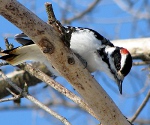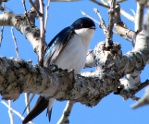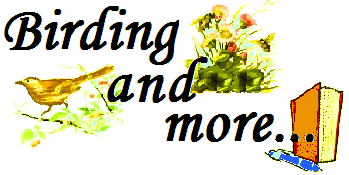 Newsletter
Newsletter
2010
/ Issue 6
IN THIS ISSUE: CHOOSING THE RIGHT BIRD FEEDERS FOR YOUR GARDEN
CHOOSING THE RIGHT BIRD FEEDERS FOR YOUR GARDEN
Typical
 ly
this will include 4 tube feeders with Nyger seed, 3 hopper style feeders
with
Safflower
seed, a
peanut feeder, a couple
of mixed seed feeders (inside cages -
to keep the
Starlings and Grackles out),
a
ly
this will include 4 tube feeders with Nyger seed, 3 hopper style feeders
with
Safflower
seed, a
peanut feeder, a couple
of mixed seed feeders (inside cages -
to keep the
Starlings and Grackles out),
a  'plug' feeder with suet or peanut butter, an
open tray feeder
with peanuts in the shell (this is primarily for the Blue Jays), plus a number of suet
feeders or hummingbird feeders (depending on the time of year). The
result is a nice array
of different birds visiting our garden all year round.
This article will help you select
'plug' feeder with suet or peanut butter, an
open tray feeder
with peanuts in the shell (this is primarily for the Blue Jays), plus a number of suet
feeders or hummingbird feeders (depending on the time of year). The
result is a nice array
of different birds visiting our garden all year round.
This article will help you select  the
right feeders and show you how to place them in your garden so that they
will attract the birds you want without any trouble from Squirrels,
the
right feeders and show you how to place them in your garden so that they
will attract the birds you want without any trouble from Squirrels,  Starlings, Grackles, or Pigeons. In a future
article I'll go into more detail about how
to achieve harmony with the so-called
'pests', but for now let's talk about the various feeder types and how
to deploy them. The three best feeders to start with are Nyger seed,
Safflower seed, and the
Starlings, Grackles, or Pigeons. In a future
article I'll go into more detail about how
to achieve harmony with the so-called
'pests', but for now let's talk about the various feeder types and how
to deploy them. The three best feeders to start with are Nyger seed,
Safflower seed, and the  Hummingbird feeders. These
feeders will bring you Finches, Chickadees, Doves, Siskins,
Redpolls, Grosbeaks,
Cardinals, and of course Hummingbirds. You can hang these feeders
anywhere
Hummingbird feeders. These
feeders will bring you Finches, Chickadees, Doves, Siskins,
Redpolls, Grosbeaks,
Cardinals, and of course Hummingbirds. You can hang these feeders
anywhere  without any trouble from
the Squirrels, Starlings, Grackles, or Pigeons. Where it starts to get a
little bit trickier, is when you decide to introduce mixed seed,
peanuts, millet, and suet. Those foods will attract the
Woodpeckers, Blue Jays, Juncos, Sparrows, and Nuthatches, but they will
also lure the Squirrels, Starlings, Pigeons, and other less desirables.
All peanut and mixed seed feeders should be hung by rope from a branch
of a tree so that the feeder is at least 4 feet off the ground and 10
feet from the nearest fence or tree trunk (to keep squirrels from
jumping onto them). They can also be hung from hooks on poles equipped
with squirrel baffles. We also suggest 'caging' the mixed seed feeders
to keep the bigger birds out - to give the little birds a chance.
Finally, we also have platform feeders for birds that like to feed on or
near the ground - but these are inevitably shared with the Squirrels -
no way around it. However, we like the Squirrels too, and by giving them
their own feeding stations they co-exist very nicely with all the fine
feathered visitors that we all like so much.
without any trouble from
the Squirrels, Starlings, Grackles, or Pigeons. Where it starts to get a
little bit trickier, is when you decide to introduce mixed seed,
peanuts, millet, and suet. Those foods will attract the
Woodpeckers, Blue Jays, Juncos, Sparrows, and Nuthatches, but they will
also lure the Squirrels, Starlings, Pigeons, and other less desirables.
All peanut and mixed seed feeders should be hung by rope from a branch
of a tree so that the feeder is at least 4 feet off the ground and 10
feet from the nearest fence or tree trunk (to keep squirrels from
jumping onto them). They can also be hung from hooks on poles equipped
with squirrel baffles. We also suggest 'caging' the mixed seed feeders
to keep the bigger birds out - to give the little birds a chance.
Finally, we also have platform feeders for birds that like to feed on or
near the ground - but these are inevitably shared with the Squirrels -
no way around it. However, we like the Squirrels too, and by giving them
their own feeding stations they co-exist very nicely with all the fine
feathered visitors that we all like so much.
THE READER'S PATCH
Pictures
of the week
A Tree
Swallow feeding its young
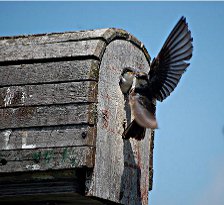
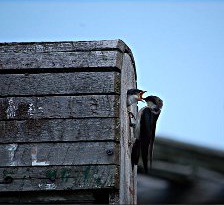
These great photos were taken by
Bob McPherson, in his backyard.
The nest is a discarded mailbox that Bob renovated into a 2 unit condo,
and the tenants return every year!
*******************
The Readers
Patch is
a space for your photos, stories, and/or comments.
Send anything
you'd like to share with us to: newsletter@birdingandmore.com
FUN FACTS ABOUT BIRDS
Did you know that the bird with the largest wings in the world is the Wandering
Albatross with a wingspan of 11'11'' - wow!!
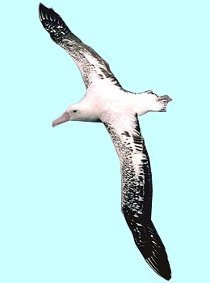
HOW TO:
CLEAN YOUR FEEDERS
1. Empty, and
discard old seed.
2. Use a butter knife or similar shaped utensil to scrap away stuck on seed
and dirt.
3. Spray and brush the feeder with a solution of 9 parts water to 1 part
vinegar.
4. Rinse vigorously.
5. Dry thoroughly before refilling with seed.
.
Feeders should be cleaned regularly to protect birds that visit your feeders
from bacterial infection and the spread of disease.
.
What's
New this week
at www.birdingandmore.com
BIG
NEWS!! We have moved the "Birding and more..." website to a new (and hopefully much better) web hosting service!! We are very excited!
![]()
Maybe now the website will be up and available all the
time, and the galleries, blog, and emails will all work without a hitch (fingers
crossed).
![]()
Send us an email and
let us know if you're not seeing the new site with your browser (you'll be able
to tell because the old site has a "Notice" on the main page saying we're moving
to a new hosting service - the new site doesn't).
Peanut Butter Mix for Birds
Is plain peanut butter a danger to birds?
Although there is no conclusive evidence to support the belief that birds can
choke on peanut butter, we always mix ours before putting it out in the plug feeder.
We combine 'crunchy' peanut butter with cornmeal, mixed together
until it is the consistency of cookie dough.
You can add seeds, bits of dried fruit, raisins, and/or chopped nuts to the mix.
It is a favourite with almost all the birds, and also the squirrels, so be
careful to place the feeders where the squirrels can't reach them - or if you
happen to like the squirrels (the way we do) crumble a little on the platform
feeders as a treat for them too!
True or False?
1. Most birds have a well refined sense of smell.
2. Male canaries sing much better than females.
3. The Mute Swan is the heaviest flying bird in the world.
4. Some birds can fly backwards.
5. The most common bird in the world is the House Sparrow.
Name these Ontario birds:
Answers to this quiz can be found at
www.birdingandmore.com/quiz.htm
It's always been my dream to have a bird/wildlife-friendly garden and thanks to the wonderful man who is my husband, that dream is coming true. I love the natural look rather than shaped and sheared, and having a wildlife-friendly garden caters to my preference! As I mentioned in the last “Elaine's Corner” (Issue 5), I prune only if necessary – either because it's a shrub that must be pruned, like the Butterfly Bush, or there is old or dead wood that should be removed. The shrubs I choose are, for the most part, shrubs that look best left to grow naturally.
One of my all-time favourites is the Honeysuckle bush
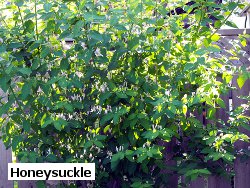 – we have three, so far. It's a standard for attracting hummingbirds and once
the berries set, others enjoy the fruit. A couple of new shrubs, for me, are the
Chokeberry and the Nannyberry. We've planted two Nannyberry bushes – apparently
there needs to be two for pollination – and one Chokeberry. The Chokeberry is
covered with beautiful, small, airy white flowers in the spring and looks like a
wispy cloud that has dropped to earth. It's now been added to our favourites
list too. They both have dark, purplish fruit in the fall which birds relish.
Squirrels seem to love the Chokeberry fruit as well and as soon as they appear,
they're gone! (Once the shrub has grown a bit larger, I'm su
– we have three, so far. It's a standard for attracting hummingbirds and once
the berries set, others enjoy the fruit. A couple of new shrubs, for me, are the
Chokeberry and the Nannyberry. We've planted two Nannyberry bushes – apparently
there needs to be two for pollination – and one Chokeberry. The Chokeberry is
covered with beautiful, small, airy white flowers in the spring and looks like a
wispy cloud that has dropped to earth. It's now been added to our favourites
list too. They both have dark, purplish fruit in the fall which birds relish.
Squirrels seem to love the Chokeberry fruit as well and as soon as they appear,
they're gone! (Once the shrub has grown a bit larger, I'm su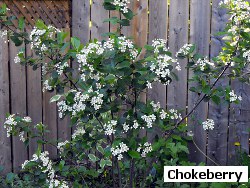 re
there will be enough for the birds to get some too...
re
there will be enough for the birds to get some too...
In addition to the above, we've included several shrubs just because we like them and I'll tell you about them in the next newsletter, so stay tuned!
If you liked our newsletter
please pass it along to your friends and family.
Subscriptions are free! Just send an
email to: newsletter@birdingandmore.com
If you wish to cancel your subscription send an email to unsubscribe@birdingandmore.com
